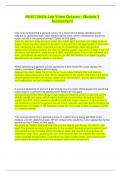N5451 Skills Lab Video Quizzes - Module 3
Assessment
The nurse is beginning a general survey on a client who is being admitted to the
hospital for abdominal pain. After identifying the client, which components would the
nurse include in the general survey? Select all that apply.
Does the person's body structure match the stated age? Are there any tubes, lines, or
drains? Does the client appear to be alert? Is the client's color appropriate for ethnicity?
After identifying the client, a general survey is completed by observing general
appearance including whether the client is wearing oxygen, has an IV or other lines, the
demeanor and behavior, body structure, BMI, and vital signs. This is then followed by a
brief, generalized assessment from head to toe with the addition of in depth targeted
assessments as needed, based on the client.
When performing a general survey assessment, how would the nurse assess the
client's orientation? Select all that apply.
Request the client states his or her name. Query about today's date and season.
Question where the client is now. When assessing for the client's orientation, the nurse
should assess the client for person, place, time, and situation. Asking about allergies
and medications are not included in orientation.
A nurse is preparing to perform a general survey of a client. What equipment would the
nurse require to perform this assessment? Select all that apply.
Sphygmomanometer Stethoscope Tape measure Standing scale The general survey
should include vital signs, which require a sphygmomanometer, as well as a height,
weight, and BMI, which require a standing scale and a tape measure. A glucometer is
not necessary to perform a general survey, it but could be used later during the physical
assessment. A Doppler is not indicated unless the nurse was unable to palpate a pulse
in a normal manner.
The nurse is performing a general survey on a client who is being admitted to the
medical unit with abdominal pain. Which components would the nurse assess during the
general survey? Select all that apply.
Ask client for today's date and time Observe the client's gait Assess the client's vital
signs The general survey is a precursor to any in-depth focused physical assessment.
The general survey provides initial information about the client's overall demeanor,
orientation, vital signs, appearance, gait, and behavior and can indicate the need for
further targeted assessments. Evaluating the client's bowel pattern and palpating the
entire abdomen would fall under the targeted abdominal assessment.
, The nurse is caring for a client who is reporting throat pain, fever, and difficulty
swallowing. Which technique should the nurse use to palpate the client's lymph nodes
for enlargement or tenderness?
Use gentle pressure, a circular manner, and palpate with bilateral finger pads to
compare both sides. The nurse should use the finger pads, in slow circular motions,
comparing both sides to feel for any enlargement, tenderness, and mobility. The nurse
should never use firm pressure nor pinch each node, because these cause discomfort
to the client. The nurse should always compare both sides to look for asymmetry or
differences.
The nurse is completing head and neck assessments on four different older adult clients
in a long-term care facility. Which findings would the nurse promptly report to the health
care provider for further testing? Select all that apply.
Obvious turbulence upon auscultation of the bilateral carotid arteries New, mild, left
sided facial droop upon inspection of the client's face Right pupil that is slightly
misshapen and is not constricting with light Obvious turbulence upon auscultation
indicates a bilateral bruit and carotid stenosis. New one-sided facial droop may indicate
a recent cerebrovascular accident, and a right pupil that is slightly misshapen and is not
constricting with light may indicate a cataract or other neurological issue. All require
further testing. A small, nontender, soft, moveable node on the right the neck upon
palpation as well as a symmetrical and mobile skull with no nodules or enlargement on
palpation are normal findings.
The nurse is performing morning assessments on the medical-surgical unit. Which
clients are most likely to have palpable lymph nodes in the neck? Select all that apply.
Woman, 62, with chronic bronchitis Man, 67, with aspiration pneumonia Lymph nodes
are usually palpable due to acute or frequent infection. Lymph nodes are not usually
palpable with disease or pathology like dehydration, heart failure, or anemia.
An intensive care nurse is caring for a client who sustained a head injury from a motor
vehicle accident. During the morning assessment, the nurse notices the following
change: pupils were equal, but now the right pupil is fully dilated and nonreactive, and
the left pupil is 3 mm and reacts to light. What is the nurse's priority action?
Notify the health care provider immediately Decreased or absent pupillary response and
uneven pupil dilation indicate blindness or increased cranial pressure and serious brain
damage. The nurse would notify the health care provider immediately, because this is a
critical change in condition. The nurse should not wait for 1 hour to reassess, because
the client's condition will continue to deteriorate and brain damage could increase.
Monitoring the client's breathing is important, but not the nurse's priority concern.
Repositioning the client will not help to reduce the cranial pressure.




